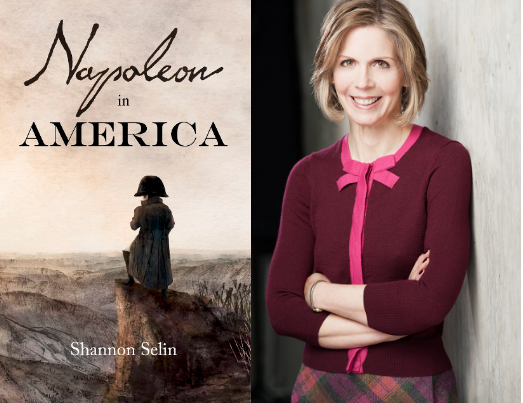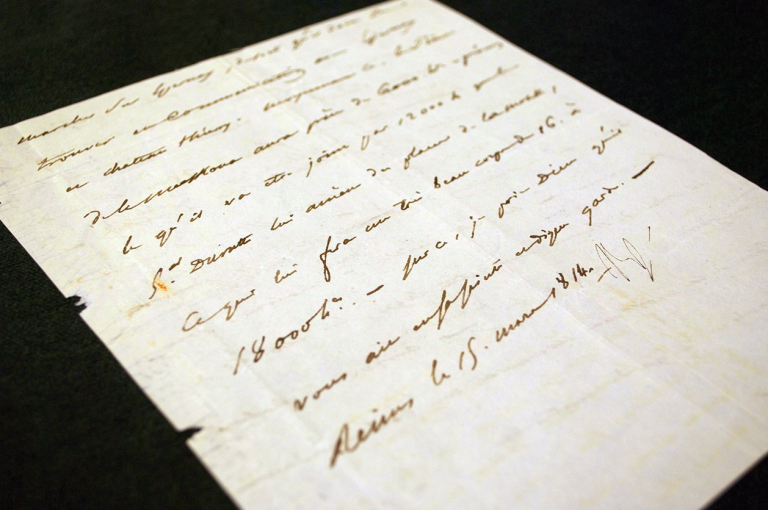
After a successful and varied career that included non-fiction writing, university research, technical writing, and working for the Canadian government, UBC alumna Shannon Selin finally returned to her first love — writing fiction. Her first novel Napoleon in America imagines what might have happened if Napoleon Bonaparte had escaped from exile on St. Helena and wound up in the United States in 1821. We spoke with Shannon about the extensive research she does for her books and how UBC Library and Collections have played a crucial role.
Which sources did you use in your research for Napoleon in America?
UBC Library has been invaluable to my research. I write historical fiction set in Europe and North America in the early 1800s. Since I try to make my novels and short stories as believable as possible, I use only actual historical characters and embed them very carefully in the social, political and geographical context of the time. I am thus particularly interested in relevant letters, diaries, memoirs, travellers’ accounts and newspapers, as well as historical maps, paintings and drawings. In addition to standard books about European and North American history, the library has a marvelous selection of relatively obscure works that I was surprised to find in Vancouver. Three of my favourites are: Papiers Intimes et Journal du Duc de Reichstadt by Jean de Bourgoing, a collection of letters, diary entries and schoolwork by Napoleon Bonaparte’s son, who died at the age of 21; The Indians of Texas in 1830 by French naturalist Jean-Louis Berlandier, which includes gorgeous plates and descriptions of the native Americans Berlandier encountered during an 1828-29 expedition; and Mexico 1825-1828: The Journal and Correspondence of Edward Thornton Tayloe, the record of an American diplomat who had adroit powers of observation. The real “shivers up the spine” moment came when I was holding a letter from Napoleon, written in 1814, and three letters from the Duke of Wellington, written in 1824, all part of the Derek Lukin Johnston collection housed in Rare Books and Special Collections.

A letter dictated by Napoleon c 1814. Note his signature at the bottom right.
Do you use UBC’s Open Collections?
I do, particularly the Andrew McCormick Maps and Prints from RBSC, which has excellent 19th century maps of the British possessions in North America. Having online access to these resources is extremely helpful. I can zoom in to see features even more clearly than I could if I were viewing the maps in person.
Can you shed some light on your research-to-writing process?
For Napoleon in America, I started by reading a lot of books about Napoleon, particularly about his time on St. Helena. What physical shape was he in? What frame of mind was he in? If someone plucked him up and carried him away, what would he be likely to say and do? I then read up on the other characters who appear in the novel – people like the Duke of Wellington, Louis XVIII, Napoleon’s siblings, the Marquis de Lafayette, John Quincy Adams, pirate Jean Laffite, and the French officers who fled to the United States after Napoleon’s defeat at the Battle of Waterloo. Since the book moves between St. Helena, various European settings and North America, I also did research on each of these places in the early 1820s, to help me imagine what it might have been like to be there. As I read, I made notes on each topic and jotted down ideas of things that could happen in the book. Based on this, I came up with an outline of the plot, and then started drafting the novel. When questions came up as I was writing each chapter, I delved into more esoteric topics: early 19th-century medical practices, the history of voodoo in New Orleans, the diplomacy surrounding the Congress of Verona, etc. This in turn sparked more ideas for scenes in the book. It is really a continuous process, in which the research and writing are closely intertwined. For Napoleon in Texas, the sequel, I have six books from UBC Library open on my desk right now, looking at questions like: What plants and animals would one encounter on a trek between Laredo and San Antonio in the early 1820s? How long would the journey by horse take, compared to the journey by mule? What kind of kit would a Mexican officer be carrying?
Do you have a favourite spot or branch of UBC Library?
Given my interest in history, it’s probably no surprise to learn that my favourite place in the UBC Library is the part that remains from the old Main Library – what is now the Chapman Learning Commons. During my first summer at UBC, I worked as a research assistant to Professor Paul Marantz in the Political Science Department. Part of my job entailed making notes from books that could not be taken out of the Ridington Room. Not to be confused with the current room of that name, this was the old humanities and social sciences reading room, located in the north wing of the Main Library. I sat at one of the long wooden tables, with the light streaming through the high windows, surrounded by portraits of UBC chancellors and the smell of old books. It was peaceful and beautiful, and being in the heritage core of the library reminds me of that space.
Borrow Napoleon in America from UBC Library.
Follow Shannon’s writing at shannonselin.com.